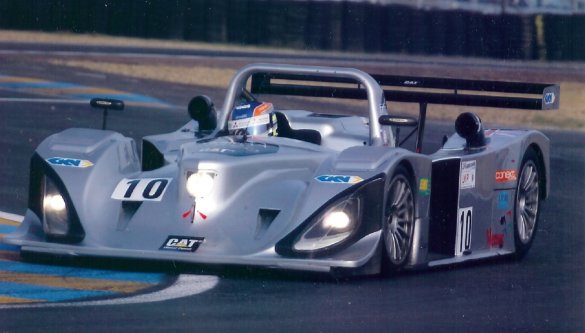|
|
|
 |
| Silverstone 1000km LMES race - August 2004 |
During the Le Mans experience, the team were thwarted by technical problems, which clouded the performance and economy of the diesel-powered sports car. However, a further opportunity presented itself, to develop the potential of the car and engine package during the month of July, and then re-demonstrate the diesel benefits at Silverstone 1000Km, 12-14th August.
Having worked intensively to resolve technical issues that had previously hindered the cars performance. These developments were shown to have vastly improved performance during the practise and qualifying sessions, followed by 4 hours of the 5.5 hour race itself.
Using the Le Mans problems as a starting point, during the (hectic) 5 week development schedule, the team concentrated their efforts in three main areas:-
-
Gear change torque management, to protect the, already proven fragile transmission.
-
Improved driveability, in particular pit lane launch, to reduce strain on a new, higher torque capacity clutch.
-
Increase rear end grip, allowing drivers to better exploit the massive torque potential of the diesel engine.
These improvements were to be fully tested at Snetterton race circuit the week before the run up to Silverstone. On the planned test day, the East Anglian summer presented the team with a flooded circuit, permitting only low speed running, this in itself highlighting the improved driveability and launch. After a few slow laps however, it was perceived suicidal (for the drivers at least!) to test the suspension modifications, so the team packed up and went home. Evaluation of the suspension modifications would have to wait for public opinion.

Enhanced rear end grip allows exploitation of the diesels torque potential
It was now that a real opportunity was presented to the PTeC team. Start the race with a fresh engine, or attempt to really explore durability and use the most hard worked engine around (already with 26 hours running, including Le Mans pre-qual) for both qualifying and the race itself. It was the latter route that was chosen, with finishing the race being an optimistic target.
On arrival at Silverstone, the team were presented with the ACO's chosen fuel for the weekend, a never seen before 'racing diesel' with properties known only to the supplier. Having considerable experience of 'special' fuels, their properties, and effects on engine performance, the PTeC team were not only suspicious of the claims, but also uneasy about the potential side effects on the engine, particularly the particulate traps.
The car left the pit lane for the first time with the usual quiet growl and a noticeably slicker launch to complete the first few laps. However, it returned shortly afterwards with performance problems, which on inspection was identified as a result of blocked particulate filters, possibly due to the fuel specification. These were swiftly exchanged for a new set and the car returned to the track, only to be seen 1 lap later suffering from the same problem. As is often the case in motor sport, a new setback is always waiting round the corner!
Some late night analysis and engine calibration changes, coupled with exhaust system modifications saw the car in the pit lane for Fridays first practice session with no particulate filters, the calibration changes being necessary to reduce, but not remove, visible smoke emissions. The car left the pits and ran for the entire session, eventually finishing the session with a time good enough for 19th. The remainder of the day was filled with similar, qualifying sessions, and bar a minor electrical problem, the car ran faultlessly qualified 24th on the grid.
Saturday morning saw ideal conditions for a 1000Km endurance race, the Taurus strategy being to start from the grid, with Phil Andrews in the driving seat and run for 40 laps (gasoline do 30) , at which point a fuel stop would be required. Unfortunately, owing to the condition of the circuit, the car saw a return to the pits after only 19 laps with some damaged bodywork caused by debris flung up by a front tyre. At this point the car was refuelled and Phil again set out onto the circuit to put in 40 laps. Just 25 laps later and the car was returned with the fuel light on, which was a little strange. It later transpired that the anti-foaming additive present in the fuel at Le Mans was not present at Silverstone, and the fuel tank had been partially filled with foam rather than fuel during the first pit stop. The car was again filled (properly) and returned to the circuit with Calum Lockie behind the wheel and in 34th place. Up until this point, the team had not been able to demonstrate the tremendous fuel economy benefit of the diesel engine, but the car had been creeping steadily up the running order only to be let down by the two previous premature stops. However, through a steady and consistent drive, Lockie managed to get the car well up into the top 20 for the best part of his session before swapping to let third driver Richard Jones have his stint behind the wheel. Mindful of the fact the engine had at this point completed around 32 hours of running, Jones' approach was a cautious and steady one. Shortly afterwards however, he had to be retired from the race, with a rear end oil leak at just over 4 hours in. An outstanding achievement for the engine, having endured 33 hours of abuse.
Considering the 33 hours this engine had run, everyone involved is delighted with the outcome. Certainly at Silverstone, without the small niggles and a fresh engine, a result near the top ten would have been possible. Work is now underway to resolve the fuel foaming and particulate filter blocking issue, and the car is expected to be running again soon. Watch this space for further updates!
| |
|



